#jammu genocide
Text
The Jammu Genocide
The Jammu Genocide refers to the period in Autumn 1947 where an estimate of over 200-250 thousand Muslims in the Jammu region by paramilitaries such as RSS Hari Singh ( the man in the picture) .

Around April 1947, RSS + other extremist paramilitaries began plans for Muslim genocide.
Following this, the Maharaja visited Jammu province but there would be no Muslim officers in the touring. Days later, he visits Rawalakot, but he would visit Hindus in the area not Muslims.

Upon return, he created new units, made of of Dogra's and Gurkha's and banned meetings of 5+ people.
He would also demand Muslims surrender their weapons...WHILE those weapons were redistributed to non-Muslims. Hari Singh viewed it as necessary for the Dogra's planned genocide.
Worth noting 60,000 from his state fought in WW2 (from the Sudhan tribe, for the British army.) and got kindly 'repaid' by disarmament and rejection from the Maharaja's army.
In August the British Raj would be partitioned on the basis of religious demographic, by this time Dogra's and Mahajan's would be desperate to exterminate Muslims and make the territory Hindu.
Many Hindu and Sikh refugees would temporarily reside in Jammu and would give highly exaggerated accounts of suffering, serving as propaganda to get a good amount of the population on board, including the refugees who had arrived recently at Jammu. These two events together would lead to a plan to exterminate Jammu's Muslim population.
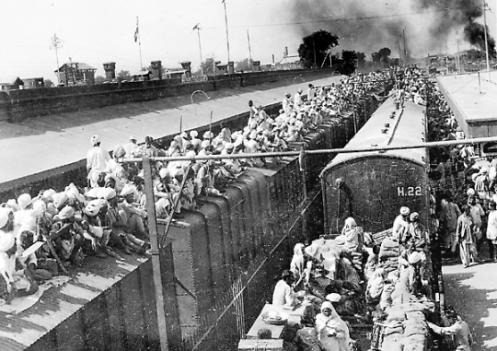
October 1947, the genocide planned out for months would begin in Bhimber tehsil, with attacks beginning with the slogan "Jai Maharaj." A common tactic was the arson of houses, this happened in 4 villages. In Kotli tehsil similar events would unfold in villages. Many would die

1 day later, a massacre would take place at Akhnoor bridge. 15k Muslims from Akhnoor and nearby would be forced to leave for Pakistan through the bridge, but Dogra soldiers opened fire killing masses of them.
Many claiming the killing was so bad blood was flowing on the bridge.
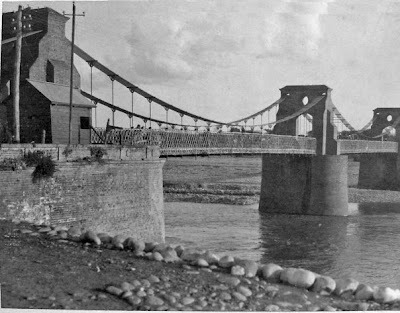
On the same day, a massacre would take place in Kathua district, with a considerable death toll of over 8000. It is claimed that women and children were not spared from these massacres and were killed to.
Only 100 of these 8000 would actually survive the massacre.

Another massacre would take place in Sambha, with Hindu & Sikh soldiers sieging it, containing 14k Muslims. Soldiers would cut rations and water.
The Maharaja would visit & after women were taken by state soldiers & men were slaughtered.
15 would survive, fleeing to Sialkot.
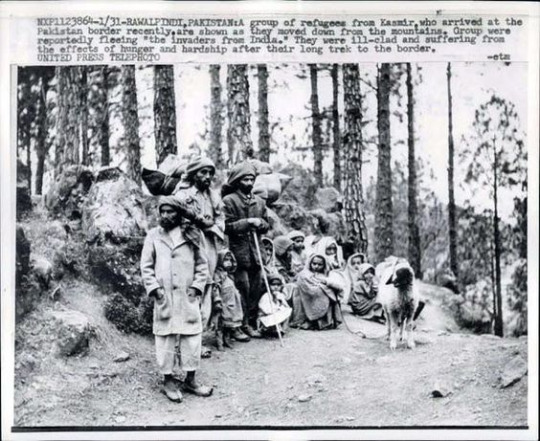
It's not over. Another massacre happened at Miran Sahib, where about 25k Muslims were SUPPOSED to be evacuated to Pakistan. As it was happening Dogra troops took away belongings and the women. Men were made to line up and be shot by machine guns.
100 survived, hiding in fields.
During November, the Maharaja demanded all Muslims leave the state, lying that Pakistan had asked for them.
They assembled at the parade ground thinking they would be sent to Suchetgarh but the convoy went to Kathua road and they were also massacred. 8000 were killed over 4 days.

As mentioned earlier, aside from the massacres, the abduction of women also took place.
These especially happened in Jammu, Kathua, Reasi and Udhampur. The number of abductions is estimated at 25k

This would all lead to mass migration of Jammu Muslims to Sialkot, Pakistan due to its closeness and a pre-established road and railway connection.
Some also went due to previous financial and familial ties to the city.

It is worth noting throughout this that the goal of the genocide was for Dogra's + RSS to take advantage of the partition's religious majority criteria (making it Hindu majority) to get accession to go one way.
This demographic idea is still used now through settler colonialism.
This website covers the genocide in more depth.
A memorial page is also under construction.
6 notes
·
View notes
Note
If BJP actually cared about the pandits then why did Amit Shah not visit the Kashmiri pandits, who were protesting for more than 200 days demanding relocation, when he visited the Jammu region?
The truth is that all political parties use us pandits for their political agendas and spreading communal hatred in valley and eventually killing the 'Kashmiriyat'.
Honestly, I’m going to agree with you and say that Shah should have visited the protestors. As a envoy for the GoI that’s his duty. Kashmiri Pandits are unhappy with the LG and how he is treating them, and as a UT central government is all they can turn to. For a government rallying for the rights of Kashmiri Pandits, they are not doing what they are expected to by the fearful KPs.
But no, I do not agree with the fact that they do not outright care for Kashmiri Pandits, and the reason for that lies in the visit itself:



After every attack spree, Shah held meetings and assessed the security.

The government is not doing a good job addressing the plighted, I will agree, but it is still doing its job in addressing the cause, so I will not go ahead and call it outright uncaring.
Yet that is just my viewpoint, and this is a sensitive issue, so if the Kashmiri Hindus feel like what has been done is not enough, then it is their call.
But yeah, whatever his reasons be, I do think he should have met with the protesting Pandits. They have a tragic history with betrayal, and the last thing they need is another government forsaking them.
But I will still not put it on the same pedestal as “other governments” because the Kashmir under Congress and the Kashmir under BJP are still as different as night and day, and you know that well. The terrorist activity has dipped, and Kashmiri Hindus are actually being given a thought. There is a reason you will see Kashmiri Hindus holding slogans like “We love you Modiji” even while protesting against the LG that GoI appointed.
And please, instead of sugar coating them as communal clashes, lets just call them what they are: attacks against Kashmiri hindus. It is not a communal clash when one group is simply dying and fleeing.
Oh, and a Kashmiriyat that faded away all eight times in the thousand year history of genocide, that could not save the people from being forced out of their homes, from being killed, from being brutally raped, allow me to say ki bhaad mein jaye aisi Kashmiriyat.
#desiblr#hindublr#kashmiri hindus#kashmiri hindu genocide#kashmiri pandit#jammu and kashmir#bjp#amit shah
14 notes
·
View notes
Text
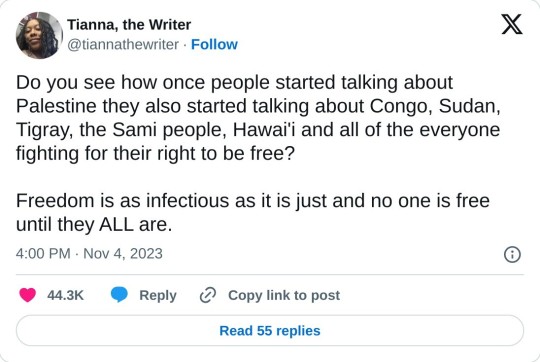
People & countries mentioned in the thread:
DR Congo - M23, Cobalt
Darfur, Sudan - International Criminal Court, CNN, BBC (Overview); Twitter Explanation on Sudan
Tigray - Human Rights Watch (Ethnic Cleansing Report)
the Sámi people - IWGIA, Euronews
Hawai'i - IWGIA
Syria - Amnesty International
Kashmir- Amnesty Summary (PDF), Wikipedia (Jammu and Kashmir), Human Rights Watch (2022)
Iran - Human Rights Watch, Morality Police (Mahsa/Jina Amini - Al Jazeera, Wikipedia)
Uyghurs - Uyghur Human Rights Project (UHRP) Q&A, Wikipedia, Al Jazeera, UN Report
Tibetans - SaveTibet.org, United Nations
Yazidi people - Wikipedia, United Nations
West Papua - Free West Papua, Genocide Watch
Yemen - Human Rights Watch (Saudi border guards kill migrants), Carrd
Sri Lanka (Tamils) - Amnesty International, Human Rights Watch
Afghans in Pakistan - Al Jazeera, NPR
Ongoing Edits: more from the notes / me
Armenians in Nagorno-Karabakh/Azerbaijan (Artsakh) - Global Conflict Tracker ("Nagorno-Karabakh Conflict"), Council on Foreign Relations, Human Rights Watch (Azerbaijan overview), Armenian Food Bank
Baháʼís in Iran - Bahá'í International Community, Amnesty, Wikipedia, Minority Rights Group International
Kafala System in the Middle East - Council on Foreign Relations, Migrant Rights
Rohingya - Human Rights Watch, UNHCR, Al Jazeera, UNICEF
Montagnards (Vietnam Highlands) - World Without Genocide, Montagnard Human Rights Organization (MHRO), VOA News
Ukraine - Human Rights Watch (April 2022), Support Ukraine Now (SUN), Ukraine Website, Schools & Education (HRW), Dnieper River advancement (Nov. 15, 2023 - Ap News)
Reblogs with Links / From Others
Indigenous Ppl of Canada, Cambodia, Mexico, Colombia
Libya
Armenia Reblog 1, Armenia Reblog 2
Armenia, Ukraine, Central African Republic, Indigenous Americans, Black ppl (US)
Rohingya (Myanmar)
More Hawai'i Links from @sageisnazty - Ka Lahui Hawaii, Nation of Hawai'i on Soverignty, Rejected Apology Resolution
From @rodeodeparis: Assyrian Policy Institute, Free Yezidi
From @is-this-a-cool-url: North American Manipur Tribal Association (NAMTA)
From @dougielombax & compiled by @azhdakha: Assyrians & Yazidis
West Sahara conflict
Last Updated: Feb. 19th, 2024 (If I missed smth before this, feel free to @ me to add it)
#resources#important#congo#sudan#tigray#sámi#hawai'i#syria#kashmir#iran#uyghurs#china#tibetans#yazidi#west papua#yemen#sri lanka#afghans in pakistan#pakistan#human rights#palestine#twitter#lmk if there's a better reource or I linked smth wrong. I am very tired#my posts#genocide#social justice#nagorno karabakh#Bahá'í#kafala system#qatar
41K notes
·
View notes
Text
पीड़ित कश्मीरी हिंदू, आख़िर कब तक | Kashmiri Pandit Genocide | Kashmir Files | Kashmir News |19Jan90
In this video, we're discussing the Kashmiri Pandit genocide, which occurred on 19 Jan 1990. The Supreme court has denied two petitions filed by the Kashmiri Pandits, and this has caused great concern and sadness among the community.
Kashmiri Pandit genocide is a term used to describe the systematic extermination of the Kashmiri Pandit community in 1990. On 19 January 1990 and The Kashmiri Pandit genocide is a dark period in Indian history that continues to haunt the nation to this day.
Kashmiri Pandits are a community of Hindus who were brutalized and killed during the Kashmiri Pandit genocide. This video discusses the events that took place on 19 Jan 1990 and the Supreme court's decision not to authorize a judicial investigation into the crimes committed. We hope that this video will bring about awareness and help to resolve this longstanding issue.
We request your support in helping us nurture the Unfiltered family. Don't forget to Like, Share, and Comment on this video. Do not forget to visit our social accounts and follow the channel for latest updates:
~=~=~= FACEBOOK ~=~=~=~
https://shorturl.at/mwLQS
~=~=~= INSTAGRAM ~=~=~=
https://shorturl.at/bGT37
~=~=~= KOOAPP ~=~=~=~=~
https://shorturl.at/INTW1
~=~=~= TWITTER ~=~=~=~=~
https://shorturl.at/bfjDG
If you haven't subscribed yet, press the Subscribe button to shower your love and blessings.
~=~=~= YOUTUBE ~=~=~=~=~
https://shorturl.at/egq03
youtube
#kashmiri#kashmiri pandits#genocide#jammu and kashmir#kashmir#narendra modi#amit shah#supreme court of india#Youtube
0 notes
Text
Freeing Palestine is India's fight
I've seen lots of posts about how Western countries and their populations should be concerned for stopping the genocide in Palestine but Indians are involved in this as well.
India has a HUGE Islamophobia problem, from the day India became what it is, this country exists the way it does through conflict regarding religious majorities and it is a problem we must acknowledge.
Collective punishment has often been carried out indiscriminately against Muslims in India- Muslim people's houses in Madhya Pradesh have been demolished without warning. This has also happened in Uttar Pradesh and in 2023, Haryana(300 businesses and homes). These were all normal innocent civilians who had proper legal paperwork showing their purchase and ownership of their home and land, but the police did not care. In many of these instances the police stood by and were involved in demolition and all of these were under BJP-majority and ruled areas. The recent Ram Mandir was built on the demolished land of Babri Masjid(it was built in the 14th century before India as it was even a THING, its destruction & demolition on the claim that it was Ram's birth place is unfair). Hate crimes against Muslims run amok and there are multiple cases of violence against Muslims in India.
PM Modi of the BJP party has been consistent in maintaining positive relations with Benjamin Netanyahu and the occupying force of Israel. A majority of the military equipment for India comes from Israel, and India has constantly been neutral in UN council meetings when decisions regarding Israel are brought up. A spyware called Pegasus, developed by the occupying force of Israel was used to surveil politicians, journalists, activists etc severely breaching right to privacy and threatening freedom of speech.
Worse; India has been using the Israeli strategy of colonizing Palestine with Kashmir. Jammu & Kashmir is a union territory which basically means they are allowed to function independently on most fronts but India has been seeking to integrate J&K into itself and has been extremely hostile to its Muslim citizens and are currently intensifying their occupation efforts. There have been consistent internet and communication blackouts since 2018 and it is STILL ongoing.
India invited Israeli officials to Kashmir to open 'Centers of Excellence' which are supposedly for agricultural innovation but everyone in J&K are concerned and see it as India taking an opportunity to intensify its occupation with Israeli help.
Speaking on condition of anonymity, several Kashmiris told Middle East Eye the Israeli agriculture hubs would deepen India's occupation in the region and accelerate its settler-colonial project.
"Earlier, we would draw the parallels between Kashmir and Palestine or India's intimate alliance with Israel. But now they are bringing Israel to the Valley in the form of these institutions - which will be "agro-oriented" in name - but we all know that Israel will physically help India in Kashmir to turn it into a proper Palestine," a Kashmiri academic based in Istanbul told Middle East Eye.
In 2016 Coalition of Civil Society said there are more than 8000 'disappearances' of people in J&K. There are mass graves with over 2000 bodies being found with these unlawful activities being attributed to the Indian Security Forces. That's just scratching the surface of decades of violence and human rights violations enacted by India.
BJP is not shy about its ties to the RSS and promotes Hindutva(I've seen people citing the literal meaning of the word as evidence that it is harmless but the word is a label given to an embraced by extreme right-wing groups who are open about their Islamaphobia. Meaning of the word becomes pointless when actions speak otherwise).
India is an occupying force on J&K, it's suppressing Muslims, demonizing them and further marginalizing them in the name of 'Hinduism'. It buys from Israel and endorses them. As Indians, it is key that we do whatever we can to stop the genocide because we are unwittingly being used to fuel this and are being radicalized to hate on our neighbors, the people we share our land and history with.
Even outside of the ways in which the current government is shamelessly supporting Israel, India's history is rife with colonization. The British had occupied us, forced us into fighting each other, into prioritizing meaningless differences to suppress each other. We were once starved by occupying forces, violated, killed. Our land is also covered in blood shed by colonization.
What are we doing if we don't speak up? If we don't stop this? Do not follow the propaganda conflating extreme right-wing ideologies with the identity of being Indian. Don't buy into the idea that India is "for Hindus", we are so ridiculously diverse, there are 100s of languages and religions in this country.
Free Jammu & Kashmir, free Palestine, stop Islamophobia.
#palestine#free gaza#desiblr#desi tumblr#gaza strip#free palestine#islamphobia#I have no special patriotism for my country but if that's the identity i'm forced into i'm going to stand up for Palestine#I am aware that Kashmiri Hindus have also experienced multiple hate crimes and were forced out and it had been classified as ethnic cleansi#but the fact that happened should only fuel you more to STOP the occupation & violence against muslims in J&K#absolutely nothing justifies genocide- nothing
32 notes
·
View notes
Note
Thank you so much for sharing that ask Nova, I needed to clarify that because I have heard a few fake rumors saying that Hijab is banned in India and as an Indian they made me annoyed.
People these days post random shit without proper research, I remember once you reblogged a long post on widely prevalent Islamophobia in a lot of regions, which was good but that post said that India has occupied Kashmir and is torturing Kashmiri Muslims, but my friend that's not the case. Kashmir's history is very complicated, it was a conflict-prone zone between India-Pakistan and China for security reasons and it became communal only after Kashmiri Muslims ki*led and chased away the native Hindus in the year 1990, millions of Hindus had to flee their homeland Kashmir and thousands were killed in that genocide, and exodus, that's when it became communal, not even one generation has passed, the Kashmiri Hindu refugees who were thrown out now live in Jammu and Delhi. That incident resulted into a lot of communal tension in India and those Kashmiri natives are not entirely innocent, it is a complicated matter and one should speak on it only when one knows enough.
Ik you didn't have any such intention but ever since I saw that post on your blog several months ago I have been dying to tell you about this.
I
oh no, thank you for telling me that. i briefly studied the issues in kashmir about the conflict of power between india and pakistan, but it wasn’t very thorough so i appreciate your input, and i’m sorry if i reblogged something that wasn’t accurate when i thought it was.
i appreciate you educating me more than anything! thank you 🫶
3 notes
·
View notes
Text
A Mining Rush Adopted The Apache Wars - Gold
Extra extensive harm was brought on by the mining of a few of the ruins for gold. Closely related to gold farming is energy-leveling. Groups in the US opposed to GMOs embody some environmental organizations, natural farming organizations, and consumer organizations. Deliberate and systematic destruction of cultural heritage, resembling that carried out by ISIL and other terrorist organizations, is regarded as a form of cultural genocide. Archived from the unique on July 1, 2013. Retrieved April 10, 2013. Part of the process of becoming a mathematics writer is, it seems, learning that you can't check with the golden ratio without following the primary mention by a phrase that goes something like 'which the historical Greeks and others believed to have divine and mystical properties.' Virtually as compulsive is the urge to add a second factoid alongside the strains of 'Leonardo Da Vinci believed that the human kind shows the golden ratio.' There just isn't a shred of evidence to again up either claim, and every motive to assume they're each false.
William H. Calvin, 2002. "A Brain for All Seasons: Human Evolution and Abrupt Local weather Change." College of Chicago Press. Calvin, John. Calvin's Commentaries, Vol. Carroll, John Millar (1991). Designing interaction: psychology at the human-computer interface. MacDonald, David; Bonocore, Mark. Tall, David; Schwarzenberger, R. L. E. (1978). "Conflicts in the educational of Actual Numbers and Limits" (PDF). Lambert, David; the Diagram Group (1990). The Dinosaur Knowledge Ebook. A rehabilitation try on the Buddha was made by Luca Olivieri and a gaggle from Italy. In 955, Emperor Shizong of the Later Zhou ordered the systematic destruction of Buddha statues resulting from the need for copper to mint coins.
The Japanese mint had to triple the production of the 100-yen piece because so many coins had been glutted within the arcades. But Area Invaders must a severe contender: shortly after the sport was released in Japan, it is extensively believed to have inspired a coin shortage, which required the availability of the 100-Yen coin to be increased. The Guardian. Retrieved June 29, 2022. Released in 1978 this early shooter pitted the player in opposition to waves of iconic alien craft; it turned probably the most profitable arcade game of the period and its big popularity was extensively credited with inflicting a coin scarcity in Japan. Japan then closed and shut achieved tens of 1000's of traditional previous Shinto shrines within the Shrine Consolidation Coverage and the Meiji government built the brand new modern 15 shrines of the Kenmu restoration as a political move to link the Meiji restoration to the Kenmu restoration for their new State Shinto cult.
It was solely as a result of 1964 Summer season Olympics in Japan that concrete replicas of those castles have been constructed for tourists. In 1860, much of the Outdated Summer season Palace, a Qing-period imperial palace, was set on fire and sacked during the Second Opium War. Following the conquest of the Old City of Jerusalem by the Arab Legion in 1948, beneath the Jordanian annexation, Jewish sites were systematically broken and destroyed. By https://laatwaaipapagaai.org/forum/profile/gladiscombs2447/ , the rebuilt temple was as soon as again ordered destroyed by Mughal emperor Aurangzeb. In 1323, when the Kakatiya dynasty refused to pay tribute to the Delhi Sultanate, Ulugh Khan beneath orders from his father and sultan Ghiyath al-Din Tughluq laid siege to the Warangal Fort and destroyed it. The famous Martand Sun Temple, located in Jammu and Kashmir, was destroyed by the Muslim Sultan Sikandar Butshikan within the early 15th century, with demolition lasting a 12 months.
1 note
·
View note
Photo
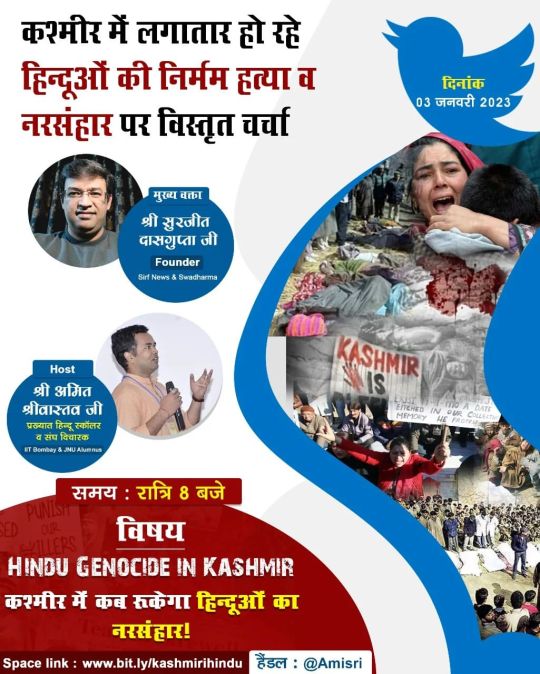
On Twitter: Discussion on the ongoing Genocide of Hindus in Jammu & Kashmir with Founder of @sirfnews & Swadharma Shri Surajit Dasgupta dada & me. Do join Twitter Space today at 8 PM! Space link: bit.ly/kashmirihindu #Kashmir #HindusUnderAttack #twitterspaces https://www.instagram.com/p/Cm8rTx0vO9K/?igshid=NGJjMDIxMWI=
0 notes
Text
Kashmir Files
The Kashmir files is an emotionally triggering, docudrama that tracks the tragic exodus of Kashmiri pandits from the state of Jammu & Kashmir, their homeland in the 1980s. The writer and director of the film Vivek Agnihotri attempt to provide an alternate view and narrative about the long-festering Kashmir issue. The film is based on testimonies of the people scarred for generations by the insurgency in the state. The Director presents the unfortunate exodus as a full-scale genocide of Kashmiri Pandits akin to the Jew holocaust and the massacre of partition at the time of India’s independence. It is the Director’s grouse that the previous governments and left-leaning intellectual lobby deliberately kept away the genocide away from the public on account of political, vested interests.
The film contains some compelling performances delivered by Anupam Kher(AK), Pallavi Joshi(PJ), Darshan Kumar (DK), Mithun Chakraborthy (MC) and others. Here, Krishna (DK) a Pandit and student of a JNU kind of university have been tutored by the leftist liberal teacher Radhika (PJ) into believing that secessionist movement like freedom of India. It is only when he visits the valley upon the death of his grandfather, Pushkar Nath (AK) that he is revealed the ‘real’ story of religious terrorism in Kashmir and the sufferings of the Pandits, who were left to die at the hands of the Kashmiri terrorists by the state and central governments.
Based on documented reports, the film shows the brutality faced by Pandits because of their religion. The camera work is excellent and successfully captures the dark brooding shades of the troubled valley in graphic detail. Agnihotri seems to have looked at the past from the prism of present circumstances. Vivek Agnihotri may be accused of opening old wounds. He gets the Kashmir militancy and partisan politics to the forefront. Reopening old wounds may not offer a solution but then healing can only happen once the trauma is accepted.
0 notes
Text
SC Dismisses Curative Petition Seeking Probe Into ‘Genocide’ Of Kashmiri Pandits
SC Dismisses Curative Petition Seeking Probe Into ‘Genocide’ Of Kashmiri Pandits
The Supreme Court has dismissed a curative petition seeking a probe by CBI/NIA or any other court-appointed agency into the alleged mass murders and genocide of Kashmiri Pandits in Jammu and Kashmir during 1989-90.

View On WordPress
0 notes
Text
The Forgotten Jammu Massacre
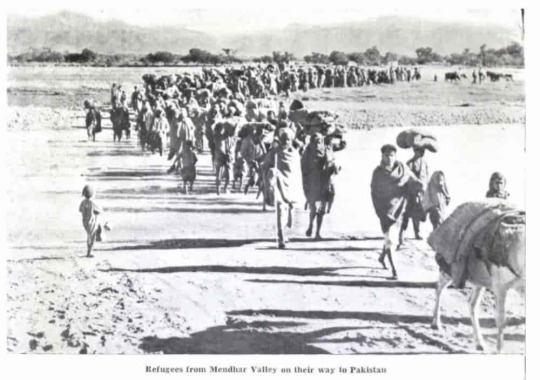
In November 1947, thousands of Muslims were murdered in Jammu by paramilitaries under the command of Maharaja Hari Singh’s army, the Hindu Dogra ruler of Jammu and Kashmir. Although the precise number of victims in the killings that lasted for two months is unknown, estimates range from 20,000 to 237,000. Nearly half a million Muslims were compelled to flee across the border into the recently formed country of Pakistan. These Muslims had to settle in the part of Kashmir that is under Pakistan’s administration. The massacre of Muslims in Jammu and the forced migration of others set off a chain of events that included a war between India and Pakistan, two newly independent countries. These incidents also gave rise to theKashmir issue. The massacres occurred as part of a British-designed strategy to divide the subcontinent into India and Pakistan, as millions of Muslims, Hindus, and Sikhs crossed the border from one side to the other.
An Orchestrated Massacre
Before the two-decade-long massacre against Jammu’s Muslim majority really began, The Rashtriya Swayamsevak Sangh (RSS) leaders from Amritsar met in secret with the Maharaja and his officials. They chose Poonch as the beginning place for the massacre of Muslims because of its record for fierce resistance. A two decade long and horrifying anti-Muslim pogrom began with the murder of a herdsman in the Panj Peer shrine and a Muslim labourer in the centre of Jammu city in the first week of September. Extremist Hindus and Sikhs committed the murders with the help and complicity of the Maharaja Hari Singh-led armies of the Dogra State. The RSS leaders and workers were complicit in organising and carrying out the atrocities.
Idrees Kanth, a fellow at the International Institute of Social History in Amsterdam who studied the history of Kashmir in the 1940s, told Al Jazeera that the immediate impact (of partition) was seen in Jammu. “The Muslim subjects from different parts of Jammu province were forcibly displaced by the Dogra Army in a programme of expulsion and murder carried out over three weeks between October-November 1947,”.
The Dogra Army personnel started evicting Muslim peasants from Jammu province in the middle of October. The majority of the refugees were housed in refugee camps in the districts of Sialkot, Jhelum, Gujrat, and Rawalpindi after being directed on foot toward West Punjab, which would eventually become a part of Pakistan.
On November 5, Kanth claimed about the Dogra Army forces’ planned evacuation of Muslims that “Instead of sending them to Sialkot, as they had been promised, the trucks drove them to wooded hills of Rajouri districts of Jammu, where they were executed.”
Demographic Changes
After the deaths and expulsion, the Muslims, who made up more than 60% of the population in the Jammu region, became a minority. According to a story from The Times, London, dated August 10, 1948: “2,37,000 Muslims were systematically exterminated – unless they escaped to Pakistan along the border – by the forces of the Dogra State headed by the Maharaja in person and aided by Hindus and Sikhs. This happened in October 1947, five days before the Pathan invasion and nine days before the Maharaja’s accession to India.”.
According to historians, the executions carried out by the Sikh and Hindu ruler’s armies were part of a “state sponsored genocide” to alter Jammu’s demographics, which had a predominately Muslim population.
Reports mention that Muslims who earlier were the majority (61 percent) in the Jammu region became a minority as a result of the Jammu massacre and subsequent migration.
According to PG Rasool, the author of a book The Historical Reality of Kashmir Dispute “The massacre of more than two lakh (two hundred thousands) Muslims was state-sponsored and state supported. The forces from Patiala Punjab were called in, RSS was brought to communalise the whole scenario and kill Muslims.”
Covering up of the Jammu Massacre
While it is unknown how many people were killed during the two-month-long killing spree, Horace Alexander’s report from The Spectator on January 16, 1948, is frequently cited. Alexander claimed that 200,000 people had died and that nearly 500,000 people had been displaced across the border into the recently formed country of Pakistan and the region of Kashmir that it controls.
India has ever since tried to free itself from the accountability of the past. The Jammu massacre has not only been left out of J&K’s historical narratives by the Indian state, but it has also been openly denied in its entirety.
Khurram Parvez, a noted human rights defender in Kashmir, told Al Jazeera that the ongoing conflict in Kashmir has its roots in 1947 massacre. “It is deliberately forgotten. Actually, the violence of that massacre in 1947 continues. Those who were forced to migrate to Pakistan have never been allowed to return,” he said.
What Does the Jammu Massacre mean for Kashmir today?
TheJammu massacregave India the opportunity to rewrite history, therefore relieving the Indian government from owning up to any responsibility for the atrocity. The Indian government is attempting to replicate this pattern in the Kashmir valley by systematically killing and exterminating Muslims and then covering it up. As more and more Indians obtain Kashmiri citizenship and are granted the ability to vote in state elections, this provides the necessary motive and encouragement for non-Kashmiris to relocate to Kashmir. While the right-wing BJP government has been milking the targeted killings of Kashmiri pandits in Kashmir. The communal violence against Muslims and the Jammu Massacre is the least talked about and written about in the history of the region.
1 note
·
View note
Text
Indian Occupied Kashmir is boiling hub of Hindu Terror (Army).
Indian Occupied Kashmir is boiling hub of Hindu Terror (Army).
Reported by Journalist Zuber
Islamabad Srinagar Tuesday Oct 11,2022
Indian Occupied Kashmir again become the cause of worry for International Community for couple of reasons. Firstly United States given advisory and asked its citizens not to travel to Indian occupied Jammu and Kashmir, due to the risk of “terrorism and civil unrest”.
Indian Army the main source of Terrorism and Genocide of…
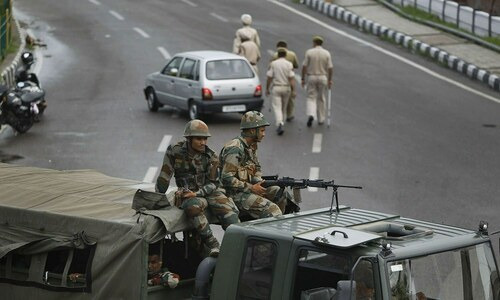
View On WordPress
0 notes
Text
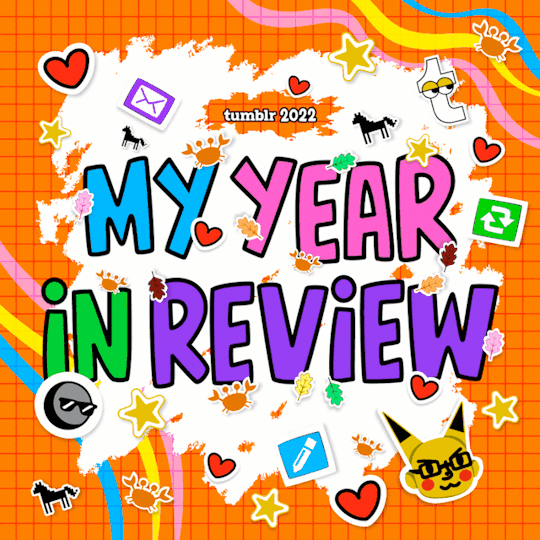
I posted 263 times in 2022
That's 263 more posts than 2021!
139 posts created (53%)
124 posts reblogged (47%)
Blogs I reblogged the most:
@pulihora
@suvarnarekha
@navaratna
@ramayantika
@shanti-ashant-hai
I tagged 256 of my posts in 2022
Only 3% of my posts had no tags
#desiblr - 173 posts
#hindublr - 21 posts
#hinduphobia - 10 posts
#hinduism - 8 posts
#kashmir - 7 posts
#jammu and kashmir - 6 posts
#kashmiri hindus - 5 posts
#kashmir genocide - 5 posts
#kanhaiya lal - 5 posts
#pakistan - 5 posts
Longest Tag: 123 characters
#won’t even be surprised if kashmir genocide is represented as “a dark time when young kashmiri girls couldn’t go to school”
My Top Posts in 2022:
#5
Movie concept: students from pan India living together in a hostel but instead we get less represented states like 7 sisters(+sikkim), Odisha, Karnataka, MP, Chhattisgarh, Jharkhand, Goa in lead along with correct representation of states like Haryana, Punjab, Tamil Nadu, Kerela, Andhra, Bihar, J&K&Ladakh in the background
46 notes - Posted November 20, 2022
#4
Just read a comic where UK and Canada were referred to as North Punjab and West Punjab and I haven’t been okay since
49 notes - Posted September 21, 2022
#3
Why isn’t mass media more neutral?
Disclaimer: I’m not taking any sides here, nor am I provoking any of you to say it, but this has been on my mind quite a bit and I feel like saying it now:
Honestly saying, I’ve always felt like the media favours Palestine over Israel way to much even tho media is supposed to be neutral.
Essays in exams, front pages of newspaper, stars on social media always talk about Palestine but seem to be painting a rather black and white “Palestine good Israel bad” picture but never seem to be willing to dwell deeper into the topic, and when they they go somewhat below the surface it’s always from Palestine’s perispective only, nothing explaining Israel’s side of story as passionately even if at all. Even in India vs Pakistan wars, you’ll find motives and aggressions from both sides easily enough if you looked.
“Stars” like Bela Hadid raise slogans demanding Israel’s dissolve under the ruse of Palestine’s independence and no one bats an eye. The founder of Human rights watch left the organisation saying that it was being biased towards Palestine and has forgotten its original purpose. A lot of funding of these pro palestine news channels comes from Pro Islamic nations organisations, most of the said countries being Palestine supporters.
Palestine is suffering, yes, but it’s not just Israel that’s making it suffer. Hamas has a major role to play too. It kills its own civilians more than Israel does. Palestine has seen some serious bloodshed since Hamas came into power but no one seems to focus on that. There’s little to no discussion about how Palestine is bleeding internally due to hamas, but only the stuff that can be used against Israel.
You’ll hear about how Israel “attacked” Gaza and most of the times it turns out to be some retaliation. We always hear about civilian deaths whose names are never revealed but no one ever wonders what civilians were doing around militant bases. We talk about how palestinians are being thrown out of Israel to show them as big aggressors and it turns out that the land was originally Israel’s territory to begin with.
I’m not being pro-Israel here, And I very well admit that it can have its fair share of violations, such as killing of the one Al-Jazeera reporter , accident or not (look, I fucking hate that platform but that doesn’t mean I condone killing of someone who didn’t do anything) but this is something that has always made me curious. It can’t be as simple as “Israel evil”, can it?
53 notes - Posted August 29, 2022
#2
Hassi to ye sochkar aati h ki mera hone waala abhi kisi aur ke saath jeeney-marne ki kasme kha rha hoga
62 notes - Posted August 5, 2022
My #1 post of 2022
What you see:

What Desi kids see:
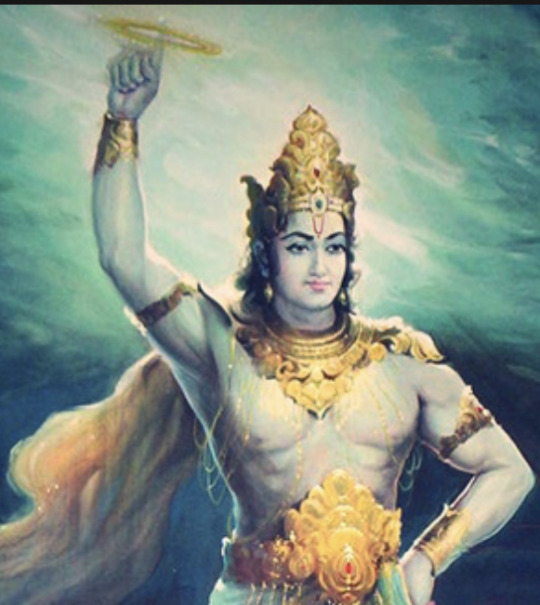
156 notes - Posted November 11, 2022
Get your Tumblr 2022 Year in Review →
#tumblr2022#year in review#my 2022 tumblr year in review#your tumblr year in review#The tags casually reminding me that this was supposed to be a political blog :’)
10 notes
·
View notes
Text
Is this Justice? Haldwani news today | Shaheen Bagh 2.0 Protest| Kashmir | Supreme Court | Haldwani
#unfilteredwithsakshi #unfiltered #supremecourt #haldwani #landencroachment #highcourt Is this Justice? Haldwani news today | Shaheen Bagh 2.0 Protest| Kashmir | Supreme Court | Haldwani, haldwani supreme court case, haldwani supreme court decision, haldwani supreme court justice, haldwani supreme court judge, supreme court justices, supreme court ruling today, supreme court of india, haldwani supreme court ruling, haldwani supreme court hearing The quick intervention by the honourable Supreme Court (SC) in the recent Haldwani protest has forced us to draw a painful parallel to the plight of the Kashmiri Pandit community. While in a swift move, SC granted respite to the demolition of 4000 encroached houses, the same SC refused to entertain the plea into the investigation of the genocide of 7-lakh Hindus who were rendered homeless on the fateful night of 19 January 1990. The constitution and the laws of Bharat pledge allegiance to the truth however, it seems the quick delivery of justice in this country is guaranteed to the ones who have a solid backing of the political power. We request your support in helping us nurture the Unfiltered family. Don't forget to Like, Share, and Comment on this video. Do not forget to visit our social accounts and follow the channel for latest updates:
~=~=~= FACEBOOK ~=~=~=~
https://shorturl.at/mwLQS
~=~=~= INSTAGRAM ~=~=~=
https://shorturl.at/bGT37
~=~=~= KOOAPP ~=~=~=~=~
https://shorturl.at/INTW1
~=~=~= TWITTER ~=~=~=~=~
https://shorturl.at/bfjDG
If you haven't subscribed yet, press the Subscribe button to shower your love and blessings.
~=~=~= YOUTUBE ~=~=~=~=~
https://shorturl.at/egq03
This video is all about public reaction show, haldwani supreme court case, haldwani supreme court decision, haldwani supreme court justice, haldwani supreme court judge, supreme court justices, supreme court ruling today, supreme court of india, haldwani supreme court ruling, haldwani supreme court hearing, नरेंद्र मोदी,narendra modi, indian politics, Haldwani News, Haldwani News Today, haldwani Doumentry, haldwani ki jameen avaidh kabja, Haldwani Demolition Row Explained, How Residents of Haldwani, haldwani public show, cutting chai, the deshbhakt, indian youtuber, aldwani news supreme court, haldwani demolition, supreme court on haldwani, supreme court in haldwani, haldwani issue, haldwani encroachment news, haldwani eviction, supreme court, haldwani eviction case, supreme court live, haldwani protest, haldwani news, 19 jan 1990, the kashmir files, kashmir, kashmiri pandit, kashmiri pandits, vivek agnihotri, kashmir news, article 370 rally, kashmir lockdown, houston kashmir protest, vivek ranjan agnihotri, jammu and kashmir, latest news, vivek agnihotri tweets, indian genocide,
youtube
#unfilteredwithsakshi#unfiltered#supremecourt#haldwani#landencroachment#highcourt#uttarakhand#Youtube
0 notes
Text
Q. & A.: What a Disturbing New Film Reveals About Modi’s Hindus Fascist India
“The Kashmir Files” depicts the decades-old exodus of Hindus from the Muslim-majority region. For nationalists, it’s perfect propaganda.
— By Isaac Chotiner | June 21, 2022 | The New Yorker
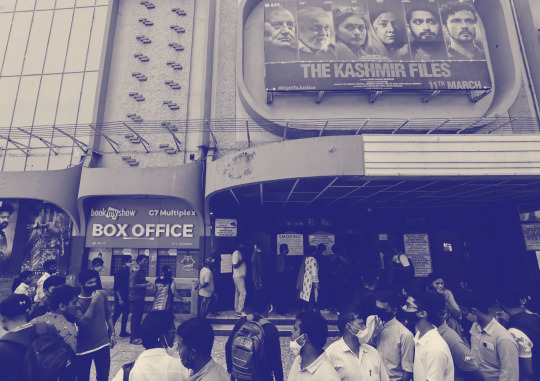
While “The Kashmir Files” seeks to portray the genuine hardships faced by Kashmiri Hindus, it is missing vital historical context. Source photograph by Francis Mascarenhas/Reuters/Alamy
Earlier this year, “The Kashmir Files”—a blood-soaked historical drama with a nearly three-hour run time—became the top-grossing Hindi film since the start of the pandemic. The contested region of Kashmir has caused unending conflict between India and Pakistan. In Indian-administered Kashmir, the Army has brutally subjected Muslims to extensive human-rights violations, with tens of thousands killed, thousands of forced disappearances, and an extremely high incidence of rape—which has been used, according to Human Rights Watch, as a “counterinsurgency tactic” to “create a climate of fear.” But this film tells a different story.
Beginning in 1989, amid an uprising of the state’s Muslim majority following a rigged election, more than a hundred thousand Kashmiri Pandits, a Hindu community, fled from their homes; as many as several hundred were killed. The film, which very clearly frames these killings as a genocide, is cross-cut between the fleeing and terrorized Pandits and a story line in the present day, during which a young Indian man challenges leftist college professors to tell the truth about what happened to his Pandit family.
“The Kashmir Files” is not subtle. Numerous scenes show angry and bloodthirsty Muslims leering at Hindu women, and inflicting torture and humiliations upon Hindu families. Though Hindus make up four-fifths of India’s population, the film presents Kashmir as a cautionary tale—that a large group of Muslims could at any moment turn against Hindus. To see it as anything other than a glorified exercise in stigmatization and fearmongering would be a mistake. And it was released in India at an especially perilous time. Communal violence directed at India’s Muslim minority has risen steeply in recent years. In 2014, Narendra Modi, who had been banned from the United States for presiding over the massacre of Muslims a dozen years earlier in the state of Gujarat, became Prime Minister of the country.
Since then, and especially since his reëlection three years ago, Modi and his Hindu-nationalist Bharatiya Janata Party (B.J.P.) have either winked at or openly supported vigilante attacks against Muslims. They have also pursued more structural forms of discrimination, such as the so-called Citizenship (Amendment) Act, passed in 2019, which could permanently revoke the citizenship rights of large communities of Muslims. After the film was released, B.J.P. politicians heaped praise on it; some Indian states waived goods-and-services tax on tickets for the movie or gave government workers time off to attend screenings. Modi himself said that the film has “shown the truth” of Kashmir in the early nineties, and the filmmakers were invited to meet with him and other hard-right politicians. Unsurprisingly, audiences have erupted into anti-Muslim chants in theatres across India, and the Indian press has reported on violence against Muslims that the perpetrators admit was inflamed by the film.
While “The Kashmir Files” seeks to portray the genuine hardships faced by Kashmiri Hindus, it is missing vital historical context. In 1947, the British departed India, partitioning the provinces of Punjab and Bengal, and creating Pakistan. This left Kashmir—whose full name is Jammu and Kashmir—as the only Muslim-majority state in India. In the first four decades after Partition, India and Pakistan waged multiple wars over Kashmir. India imprisoned Kashmiri leaders and reduced the state’s autonomy. Then, in 1987, the Indian government rigged an election in Kashmir, insuring that politicians aligned with New Delhi remained in power. During the next thirty-five years, a number of developments have exacerbated tensions: the government stationed hundreds of thousands more troops in the state, and they frequently operated (and still operate) with impunity; Kashmiris launched a full-on push for independence; and Islamist groups, often backed by Pakistan, became more prominent in the battle against the Indian state.
In 2019, the Modi government stripped Kashmir of the special status it was granted after Partition, under Article 370 of the Indian Constitution. Although Article 370 had already been steadily eroded, the formal revocation, which allowed non-Kashmiris to buy land in the region for the first time in decades, raised fears that Modi’s government had plans for a settler-colonial project for Hindus.
I went to see “The Kashmir Files” in Northern California. (It has already grossed a million dollars in the United States and Canada.) I then spoke by phone twice with its director, Vivek Agnihotri, who has made a number of Indian films, most notably a conspiracy-laden thriller about the death of a former Indian Prime Minister. Recently, on Twitter and in the press, he has attacked much of the coverage of the movie, saying it is based on an anti-Indian and anti-Modi agenda. His rhetoric echoes that of many of Modi’s supporters, who attribute opposition to the Prime Minister’s policies—and concerns about Indian democracy—to a bigoted anti-Hinduism.
Our conversation, edited for length and clarity, is below. In it, we discuss the violence sparked by the film, the Indian government’s support for it, and how Modi has changed India.
What role did the Indian government play in helping with the film?
The government gave us zero help. When we started the film, we decided we would not go to any politicians or the government. We did it purely on our own effort. We collaborated with the global Kashmiri diaspora. The government had nothing to do with this film. It was purely our effort—me and my wife. We started the film with our money; we ended the film with our money. We started showing the film in November, in the U.S. We screened it in sixteen different cities, and our focus was more on inviting Congress members and senators and policymakers and mayors and all these kinds of people, because we wanted to impress upon the world that such a great tragedy took place in India and nobody even noticed it. We wanted people to recognize it happened, because more than seven hundred thousand Kashmiri Hindus don’t live in their motherland—they live as refugees all over the world. [Historians estimate that around sixty thousand Hindu families left Kashmir in the early nineties.] And it was never a mainstream topic.
America is a champion of human rights and humanity, so it was important to go there—because I was fully aware, and I’m telling it for the first time on record, that if I started screening the film in India, it would instantly become political. And I wanted to focus on humanity. So we travelled, me and my wife, for almost two months in the U.S. There was a congressional reception at the Capitol. We were invited to all these places. I made a lot of speeches. All my speeches were about humanity and oneness.
Who hosted the congressional reception?
Raja Krishnamoorthi [a Democratic congressman from Illinois] came and gave a speech. Mark Warner, who is a co-chair of the India Caucus, and a Democratic senator, was also involved in that. Then thirty-six organizations of different ethnicities came together and said that we will do the logistics, and my production house did the funding. Thirty-six organizations, including Jewish associations, Christian organizations, Muslims from Syria, Muslims from Afghanistan—all these people came together and we showed it to people in jam-packed houses. [A spokesman for Krishnamoorthi said that the congressman hadn’t seen “The Kashmir Files” or praised it, adding that Krishnamoorthi “remains deeply concerned by the recent increase in communal tensions in India, including the anti-Muslim hate speech and violence which have been inspired by the film.” Warner’s spokeswoman said that he hadn’t seen the movie, either, and that he understood the event, which he did not attend, to have been a celebration of the contributions made by the Indian American Kashmiri-Pandit community.]
Then these people started raising funds and they put up a big billboard in Times Square for India’s Republic Day, which is the 26th of January. It created a lot of word of mouth and a euphoria on social media, because all the Indian diaspora in the U.S.—they started writing to their friends, family, parents in India. This film had zero marketing budget, zero—not even one penny was spent on marketing. And then all these people started promoting the film. The studio releasing it [in India] had no faith in the film, so they released it on four hundred screens, which became six hundred screens. And then the next day, on public demand, suddenly it became one thousand, two thousand screens. [Zee Studios, which distributed the film, said that it did invest in marketing for the movie, and that the rollout had been “a pre-decided business strategy” made in agreement with Agnihotri.]
It became part of mainstream discourse. Then obviously the politicians got involved in this because it’s their voters, their constituencies, talking. And then Prime Minister Modi made a comment. [Modi said, in part: “Instead of assessing the film on the basis of facts, a campaign is on to discredit it. The entire ecosystem opposes anyone who dares to show the truth. He tried to depict what he thought was the truth. But there is reluctance to understand or accept the truth.”] And, after the Prime Minister said that, then obviously the opposition jumped into it, and you know how it happened—then it’s like it’s not my film anymore. It’s owned by the people.
And it was eventually declared that people could go see it tax free in a number of states, right?
Yeah. In India, there’s a tradition of making films tax free, those which are found useful to the society. So nothing unusual about it.
When you met with Modi and Yogi Adityanath, the Chief Minister of Uttar Pradesh, what did they tell you about the film?
When you meet these kinds of people, they praise you for your effort. [Adityanath, who once formed a vigilante group to target Muslims, has referred to Muslims as a “crop of two-legged animals that has to be stopped.”] It was impossible to make a film about the Kashmiri Hindu genocide. The reason was terrorism; everybody was scared. But then we decided to do it. People came to my office and hit my manager. I was heckled. So now the government of India has given me security. And this is exactly why people do not make movies on the Kashmiri Hindu genocide, because it is assumed that, if Hindus are in the majority in India, then they’re powerful everywhere, but this is wrong. When “Schindler’s List” was made, the whole world appreciated it and people said, “Yes, you brought the truth out.” But imagine making “Schindler’s List” when the Nazis were ruling. Imagine making it when Hitler was ruling. Now terrorism is ruling.
Sorry, just to clarify—you’re saying that making “Schindler’s List” when Hitler was ruling is akin to what’s happening now, because terrorists rule in India today?
Oh, of course. I don’t think there is any human being who’s going to appreciate the terrorist activities. Our film is very clearly about what happens when terrorism seeps in and when humanity is absent. And, therefore, the impact of the movie as desired by me as a filmmaker is exactly what is happening. People are crying, they’re hugging each other, they’re saying, “We are sorry.” And the whole entire India is coming together. And that’s why there is so much euphoria.
Do terrorists have that much power in modern-day India?
Of course. Yes. They are killing people every day. In Kashmir, there is a death threat on my name. Fatwa, it is called, f-a-t-w-a, which is an Islamic order to kill somebody. [A fatwa is a legal decree or opinion given by a jurist about a point of Islamic law. Instances in which they call for someone’s death are rare.] And so there’s a fatwa on my name. I cannot go there freely. Obviously, terrorists are having a good day there.
Is that changing? A character in the movie says that India finally has a Prime Minister who is feared rather than loved. Do you think that the Modi government has ushered in a new kind of India?
A lot has changed. Conversation was not acceptable, and for the first time the entire country has woken up to this truth. All the generation born after 1990 has no idea what happened over there.
But has Modi ushered in a new India?
The current government has abrogated Article 370.
In 2019.
Yeah, so he abrogated that. Once he abrogated that, suddenly the hope has come back. There was no hope before that. It means that, today, if anybody else from India wants to settle over there, he can. If the Kashmiri Hindus want to go back, they can. [Since 2019, New Delhi has implemented de-facto martial law and a communications blackout in Kashmir. More recently, an increase in violence against Hindus in the region has caused some returnees to flee again.]
What about the Muslims in Kashmir, where the Indian Army, which occupies Kashmir, is very brutal with the people—subjecting them to violence and rape. What do you think about that?
I think that is ninety-nine per cent a one-sided narrative. Propaganda.
So, fake news?
It’s not fake news. This is a fake narrative. Fake news, I understand. But it’s a fake narrative—it’s a well-organized narrative. And there is not even one case where anybody has been able to prove that the Army has done it. The terrorists dress up as Army people; they will kill people and then take photos and they try to brainwash young and uneducated people. [The Indian Army in Kashmir operates under the Armed Forces (Special Powers) Act, which essentially exempts the military from any form of prosecution. In 2015, Amnesty International reported on thousands of civilian deaths at the hands of security forces, adding that “to date, not a single member of the security forces deployed in Jammu and Kashmir over the past 25 years has been tried for alleged human rights violations in a civilian court. An absence of accountability has ensured that security force personnel continue to operate in a manner that facilitates serious human rights violations.”]
You seem to be arguing that the “fake narrative” is pushed not just by the media but that professors and intellectuals have propagated a “fake narrative” of what happened in Kashmir.
Every single person we interviewed brought to our notice that they are a victim of two kinds of terrorism. One is terrorists with arms and the second terrorism is all these genocide deniers who are primarily influencers, intellectuals, people in the media, people in government, and lot of international press. So, the film basically focusses on how this genocide is being denied by the people who had the power to accept it and show compassion and empathy, and fight for their justice. But they denied these people even the acknowledgment. And, therefore, you can talk to any Kashmiri Hindu anywhere in the world, and he will tell you exactly the same thing—that they did not even acknowledge that anything like this happened. And, after this film, every single person is saying, “Yes, indeed, it was a genocide.” Even the deniers are accepting that it was a genocide. Their only complaint now is “Why aren’t we showing the other side of that story?” Because there is no other side to terrorism. It is evil. That’s it.
How much do you feel that your film is representative of this new India ushered in by Modi? I know you’re a supporter of the Prime Minister.
It’s important because the film is based on truth, absolute truth. In fact, as you call me, I’m walking into the British Parliament to give a speech. Before 2014, the Hindus were not feeling empowered. They were feeling weak. And now they are able to voice openly. But my filmmaking has got nothing to do with it.And supporting the Prime Minister doesn’t mean that my films have got anything to do with him. So correlating these two things—my films and the Prime Minister or the political party in power—would be, I think, a wrong comparison. “The Kashmir Files” is a soft, emotional film.
“A soft, emotional film.” Is that what you said?
It’s an emotional film. It’s got a more feature-film format rather than a harsh statement.
There is a scene in which a woman is forced to eat rice soaked in her husband’s blood.
Yeah. And we try to dilute them because the truth is harsher than that.
One thing I hear from supporters of Modi is that Hindus are now more willing to express so-called Hindu values and so on. Do you think that’s become easier?
Of course, of course. Definitely, it’s become easier because B.J.P. is not like Congress, which ignored the Hindu voice. So I think Modi has become a voice of the voiceless. That’s my analysis.
The voiceless eighty per cent of the country—the Hindus?
No, no. One second. Not just Hindus. India’s a complex country. It’s not just Hindus and Muslims. You cannot divide it like that. Actually, minorities in India are Parsis and Jains and Sikhs, and they are also very supportive of Modi. And there are the Dalits, who are called the Scheduled Castes. They did not have a voice earlier. They’ve also found a voice in it.
There has been a lot written about people going to see the film and then engaging in violence against Muslims. Is that something you’re concerned about?
Do you have any confirmed reports of that? Is there any police report, any video where people have become violent? It depends which side of the media you are reading. If you’re reading anti-Modi media, they will say that.
In Khargone, in Madhya Pradesh?
This is very selective. But the thing is, this is the most viewed film ever, which means that the majority has no problems with the film, and the people who are writing these kinds of things are the people who have not seen the film themselves. So this is a very political opinion. The film has no problem. It has healed seven hundred thousand Kashmiri Hindu families. You saw the blood-soaked rice that the woman eats? Her daughter wrote a letter to us, saying that the family was wrecked, and, for the first time in thirty-two years, this film has healed their family. Similarly, in the end, you have seen the woman who was cut on a saw machine. Her family wrote to us saying that this is the first time, after thirty-two years, they’re feeling that somebody is listening to them, and they feel that justice is being done and their family is healing.
One thing I hear you say is that “facts are not facts.” What do you mean by that?
Oh, it was in the context of a person who was interviewing me. It was edited. He edited it to his advantage to take the context out. The complete sentence was “Facts are not facts if they’re coming from people like you.” This was the complete sentence.
You tweeted that, too: “Facts are not facts.”
I always tweet “facts are not facts” if they’re coming from communists or Naxalites.
I want to ask this again. We have seen viral videos on social media with people yelling derogatory things about Muslims in movie theatres where your movie is playing. You’re not at all concerned about that?
How many videos like that were there?
I don’t know the exact number.
Yeah. That’s the problem. Everybody’s talking about it, but nobody knows, so it is based on fake news. There was only one person, one crazy guy who shouted something. O.K., that was one in 1.3 billion people. But there are thousands and thousands of viral videos where Kashmiri Pandit women are hugging me and crying on my shoulders.
That one video—it was a fabricated thing. It was made only to create noise against the film. But, otherwise, there is not one case. There is not even one police complaint. You won’t find even one person in the entire country of 1.3 billion people who has seen or heard somebody say something like that, except for a bunch of media people who have been creating this fake news.
But listen. I want to talk to you human-to-human. You asked me a question that is not based on something which you know for sure. Similarly now, if I fall into the trap and I answer that to defend it, then others will ask. So everybody from foreign media has been asking me this question, but none of them have seen any video. None of them know of any case like that.
I have seen these videos on social media. I can link to them in the article. Would that be helpful if I link to the videos?
Are we done?
Would it be helpful if I linked to the videos in the article?
You can, undoubtedly. But you have to prove that it’s not fabricated, that it’s not the opposition that has sent it, some terror groups that have sent some person to create this bad thing. Because, if it was really genuine, then there would’ve been a police case or something. There is nothing, no records.
Some of these videos have actually been shared approvingly by people within the B.J.P.
I don’t know. I’m not answerable for anyone. I can answer only for my own film. We have made an honest film. Not even one person in the entire universe has been able to point that one line of dialogue, one shot, any one scene in the film is wrong. So my theme is based on truth. If truth hurts people, offends people, I don’t care about it. ♦
0 notes